See likes given/taken
| Post info | No. of Likes |
|---|---|
|
The Moon and The Crust
Erkka was visiting me last weekend and some really exciting weather engine achievements and accompanying real life adventures were made. Now there are two new essential weather features on the table - both still somewhat under construction, but most likely to be seen in the next version. And the features are... * The moon. Our weather engine now models the moon in detail, with its' changing phases and moonlight affecting to the nighttime visibility and brightness. Lots of tuning is still pending, but we can already see that the full-moon nights in the game will be a different experience. Especially during the darkest seasons moonlight can be a of great help and extended the available hours for working, hunting or travelling. Just have a look at the screenshot compilation below. 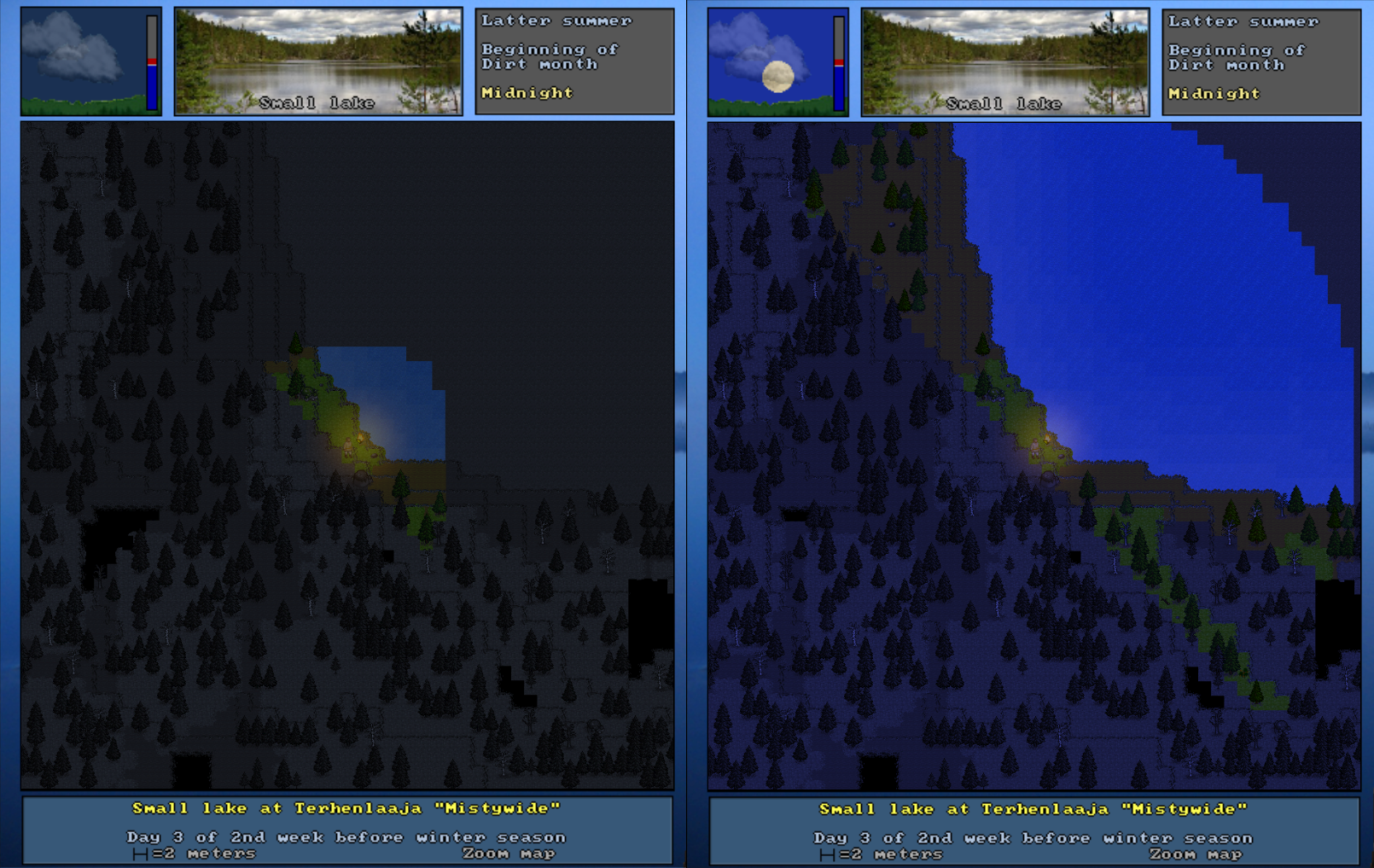 Left: A casual midnight by the lake in dirt month as it appears currently in the game. Right: The same scenery with the new moon code in action. It's full moon and our nighttime visibility is a much different. * Snow crust Snow crust is a springtime phenomena where surface of the snowpack becomes so hard that it can completely support a walking or skiing person. The crust results from partial melting of the snow surface by warm spring day sunlight followed by re-freezing when the temperature drops again, usually after the sunset. The crust normally only lasts for part of the day, but being able to travel on snow without sinking in there at all is a great asset for a hunter. Elks were traditionally hunted on skis during crust as it can't support the heavy animals and hunter gliding on crust with skis now became much faster than their prey. Lots of work is still needed before snow crust support is all coded, but that's the intention. Now it also requires proper snow penalty to be added for NPCs and animals, and reworking the skiing code to some extent too. (And if you were thinking of skiing NPCs so were we.) The last weekend it was both full moon and snow crust possibility, so we also went experiencing these things in real life. Naturally these both are familiar experiences already, and as countryside kids we've learned possibilities of snow crust for work and leisure all the way from our childhood. But if you'd like to see the magic of skiing in moonlight without any artificial light, or get an idea about difference between skiing in slushy spring snow compared to the crust, we've got a short videoclip for you: https://www.youtube.com/watch?v=JOcb_cm5UkE March 29, 2021, 05:36:42 PM |
19 |
Re: The Moon and The Crust
Love the moon light wondering if you also were going to add in cloud effects? While and overcast day wouldn't effect visibility there would be a huge difference between clear full moon and on one a cloudy night. Yes, the cloudiness is also taken into account, as well as the lunar phase. It all contributes to how much extra light there will be. March 29, 2021, 06:31:37 PM |
3 |
|
Re: Why did the villagers become hostile?
This issue is fixed now. It was first reported here: https://www.unrealworld.fi/forums/index.php?topic=5707.0 Villagers mistakenly consider the fire making attempt illegal if there were certain size warm embers at the site. Fixed - persists in 3.63. April 01, 2021, 06:46:26 PM |
1 |
Re: The Moon and The Crust
Love the moon light wondering if you also were going to add in cloud effects? While and overcast day wouldn't effect visibility there would be a huge difference between clear full moon and on one a cloudy night. And Erkka too. This greatly a two-man team effort. April 13, 2021, 06:06:57 PM |
4 |
|
Fibre processing continues with retting and some spin-off features
By now spinning code is all done and tested and polished, and we're happily able to spin both nettle and hemp yarn. With some new flora_*.txt tags added it's actually possible to add fibre yield for any flora_*.txt plant, although the textilecraft processes are modelled for nettle and hemp. But yes indeed for example flax as a new fibre source can be added relatively easily. We've also added straw, a mere stalk of certain plants, as a new item type. Straws will be a byproduct of threshing plants such as nettles and hemp, but with a flora_ tag of their other plants can be also given straw yield. Straws don't (yet) have specific use of their own but do serve as material for fibre processing. Straw items were added for the sake of being able to thresh valuable plants for seeds and leaves first, and still have the straw remaining for fibre. And now there's "retting" added for textilecraft options. It's a process for separating the fibres from the stalks of harvested plants, and the first and foremost option of them all. Retting is done by soaking the plants in the water for several days. The soaking needs to be done by open water and the sufficient soaking time depends on the water temperature, varying from 5 to even 25 days. The warmer the water, the faster the retting process is. The retting doesn't occur at all in very cold water so it can't be done for example in the winter. However, nettles are a speciality and you can peel fibres from them by hand without retting, but it's relatively slow and mostly used only if small amount of yarn needs to be spun. Now the remaining steps to do on our way to completely finished textilecraft system for fibre processing would be drying the retted plants, and extracting the fibre. So let's continue ... These are future additions - not yet functional in current version 3.63. April 19, 2021, 04:48:22 PM |
16 |
Re: Fibre processing continues with retting and some spin-off features
Would villages process their raw hemp and nettle too? If so, it could be interesting to tie the final fibre stock in a village, to its rate of clothing production (chance of finding a nettle/linen clothing item). Actually yarn will be available as village product, so you can find nettle and hemp yarn from villages every now and then. However, its' availability and restock rate isn't modelled with that much precision. April 22, 2021, 04:34:15 PM |
1 |
|
Fibre processing done
So, the system of processing fibres from hemp and nettle into yarn is now all coded. Small adjustments remain, but we've happily accomplished mechanics for all the work phases and necessary adjustment to data structures. Adding this system of textilecraft has been likely the most laborous single feature to code in the upcoming version. With several other features regarding tying equipment we can talk about sort of cordage overhaul. Soon enough I'll be posting more organized entry about the whole system with screenshots, but now let's quickly cover what hasn't been covered in the earlier textilecraft news. So, the final two additions to textilecraft system were drying the retted plants and the actual extracting of fibre. Drying is simplified. It takes about a week for retted plants to dry before extracting the fibre can be proceeded. And you can basically set them drying anywhere. The idea of extracting the fibres is to break the dried retted stalks so that the woody core shatters and falls away leaving the loose fibres free. Traditionally this was done with a special device called ‘loukku’, but in the game we use more primitive method of beating the stalks for example with a club on a solid working surface. The requirements are similar to softening hides as a last step of tanning; beater and a working surface. Extracting fibres is hard physical work and commonly carried out with several people working together. If you have companions around they will help you with the task. After the breaking phase, obtained bundles of fibre are scraped free from remaining coarse parts and extraneous material. This is done in steps, first removing the biggest extraneous parts and gradually proceeding towards the finer ones. Traditionally special tools, combs and brushes were used to clean the bundles of fibre as effectively as possible. In more primitive fashion it can be also done by whisking, rubbing and whacking the bundles against a hard surface, or with tools at hand. In the game this is the method used, and the equipment available for breaking is applied here as well. All these required phases are done with single textilecraft option. Extracted fibres are obtained in small bundles, eg. "bundle of hemp fibre". These items are categorized as PLANT type in character's inventory. As mentioned before, nettle fibres can be also extracted directly from the stalk by hand even without retting. Although it's slower to mass produce fibre that way it can be useful option when only a small amount of fibre is needed. To do it, simply use extract option directly to freshly harvested nettles. The nettle stem is crushed by hand, and the fibres carefully stripped off. Character's expertise in textilecraft affects to required working time and amount of usable fibre extracted. So as your mastery in textilecraft increases you can expect to get higher fibre yield in shorter time. These are future additions - not yet functional in current version 3.63. May 06, 2021, 04:19:40 PM |
13 |
Re: Fibre processing done
Can we harvest nettle for fiber purposes prior to the plant ripening to edible harvest? Yep. And other textile plants too when they've reached the age of about 30-35% of their total growth time. May 11, 2021, 03:40:39 PM |
3 |
|
Sneak preview of textilecraft system with screenshots and additional insight
Time for a little sneak preview with our textilecraft test character Kuitu Kaumolainen. Some of the stuff mentioned here has been mentioned before, but a summary about textilecraft is in place now. With some sdditional insight and sidetracking included. So, the biggest single addition to the upcoming version is featuring mechanics to extract fibres from certain plants and process them into yarn. For this, a new TEXTILECRAFT skill was created, and lots of spin-off features regarding fibre processing and cordage also followed. Fibres can be extracted from nettle, hemp and flax - which has been added as a new cultivated plant. Let's start from there ... Flax Flax is an old cultivated textile plant, but in Iron-Age Finland it wasn't even as commonly grown as hemp. One reason for this is that flax doesn't survive in the very north so in the game it's grown only by certain cultures south of Kaumo. As a curiosity, the finnish word for flax ('pellava') originally meant the nettle plant ('nokkonen') which speaks about importance of this age-old wild source of fibre. But nevertheless, flax is in the game now and it can be grown, harvested and processed for fibre. 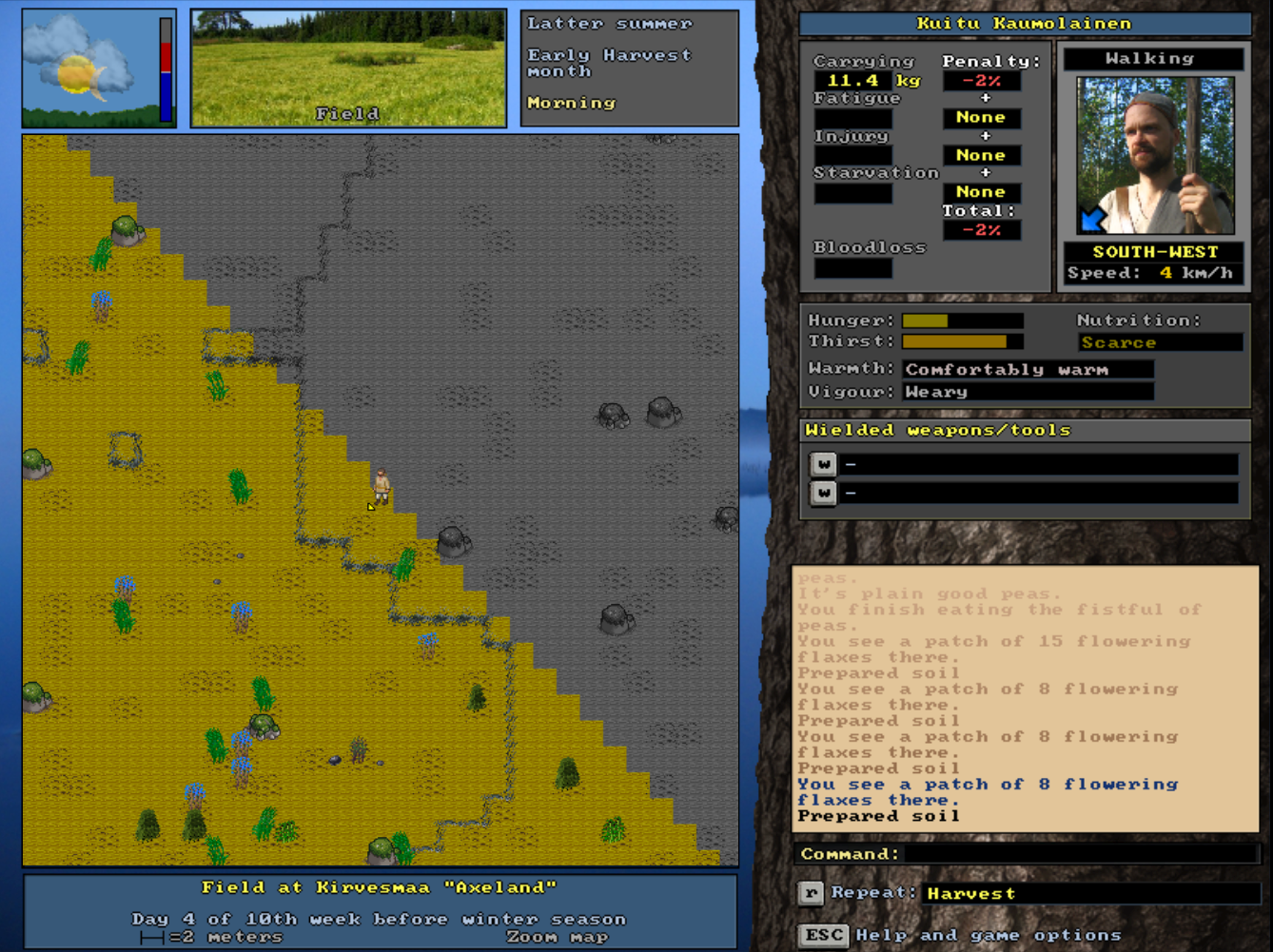 Kuitu Kaumolainen has found his way to Kiesse, a region where flax is grown. At Kaumo where he's from they only produce nettle or hemp fibres. Blue flowering flax is easily spotted from the field, and it could be harvested for fibre already. Textilecraft options Processing plant fibres into yarn involves several stages of work, and it's all done by using your TEXTILECRAFT skill. Character's expertise in textilecraft affects to required working times and the amount of usable fibre or yarn produced. After the plants are harvested the fibres must be then separated from the plant's stalks. This process is called "retting", and it is done by soaking the plants in the water for several days. Sufficient soaking time depends on the water temperature, with the warmer being faster. 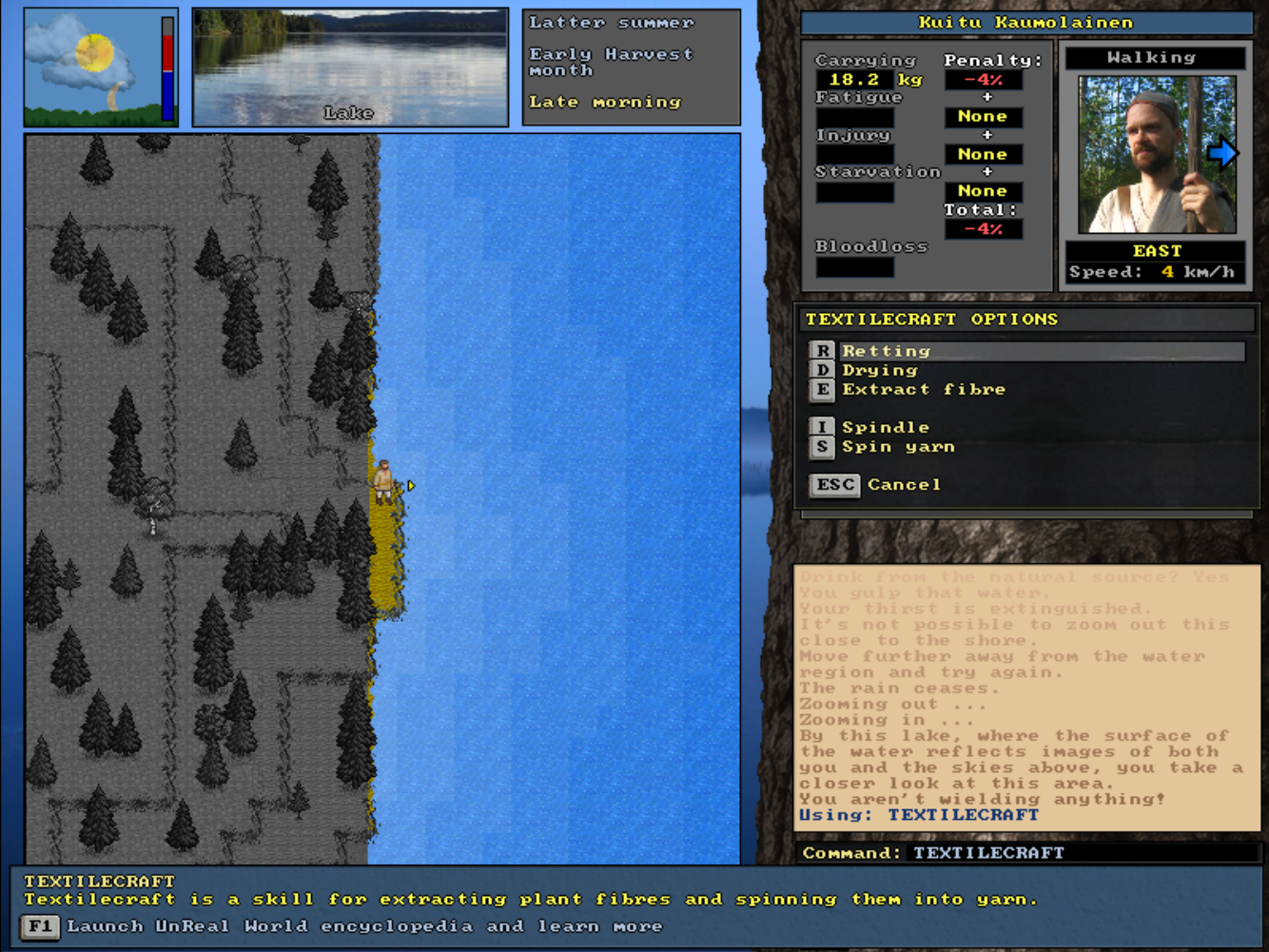 Kuitu Kaumolainen harvested 100 flaxes and headed by the lake to start retting the stalks. Here you can see all the textilecraft options to proceed with fibre extracting and spinning them into yarn. Extracting fibres is hard work It took two weeks for Kuitu's flax to soak properly. After that it took one more week to dry them. And only then Kuitu can start extracting the actual fibre from the stalks. Extracting fibres is done by breaking the dried retted stalks so that the woody core shatters and falls away leaving the loose fibres free. The stalks are beated for example with a club on a solid working surface. Extracting fibres is hard work and commonly carried out with several people working together. Traditionally there has been a custom to arrange specific work parties for processing fibres of each village together with the neighbouring people. And in the game your companions can actually help you with the task. Obtained bundles of fibre are then scraped free from remaining coarse parts. Traditionally special tools were used, but it can be also done by rubbing and whacking the bundles against a hard surface, or with tools at hand. 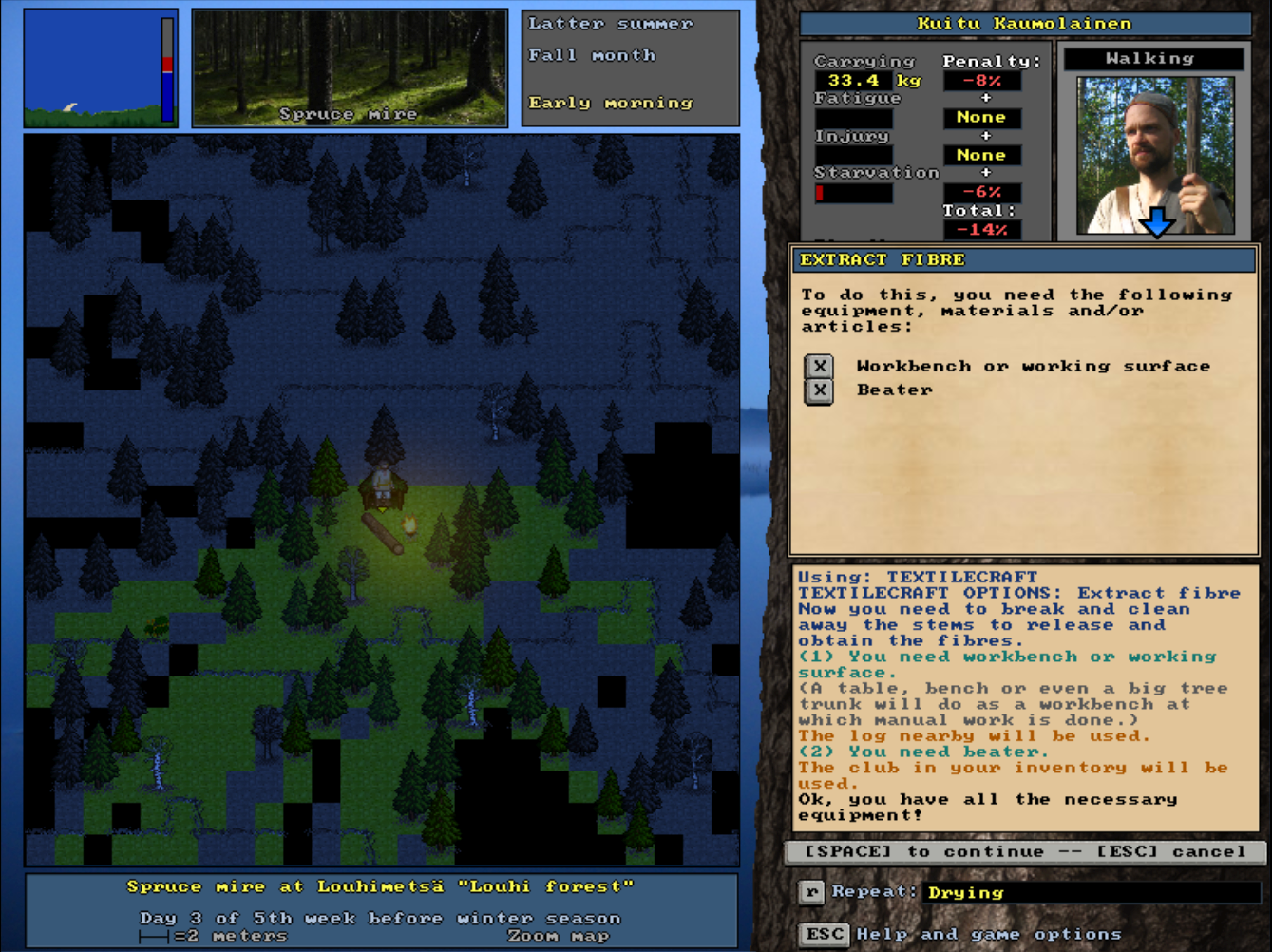 Kuitu starts extracting fibres from the dried retted flax stalks at his shelter. He is about to beat the stalks with a club on top of a log. These dried retted stalks could have been also stored for future and the fibre extracted when there's time and need for that. Spinning yarn It took lees than half an hour to extract the fibres from his 100 flax stalks and Kuitu got 16 bundles of flax fibre. Fibres can be then spun into yarn either by hand, which is slower, or using a spindle. Spindle is also a new craftable item, and very easy to make. So Kuitu crafts a spindle and starts spinning. He decides to go for full length yarn. When starting spinning it is possible to choose how long yarn you wish to spin on one go. 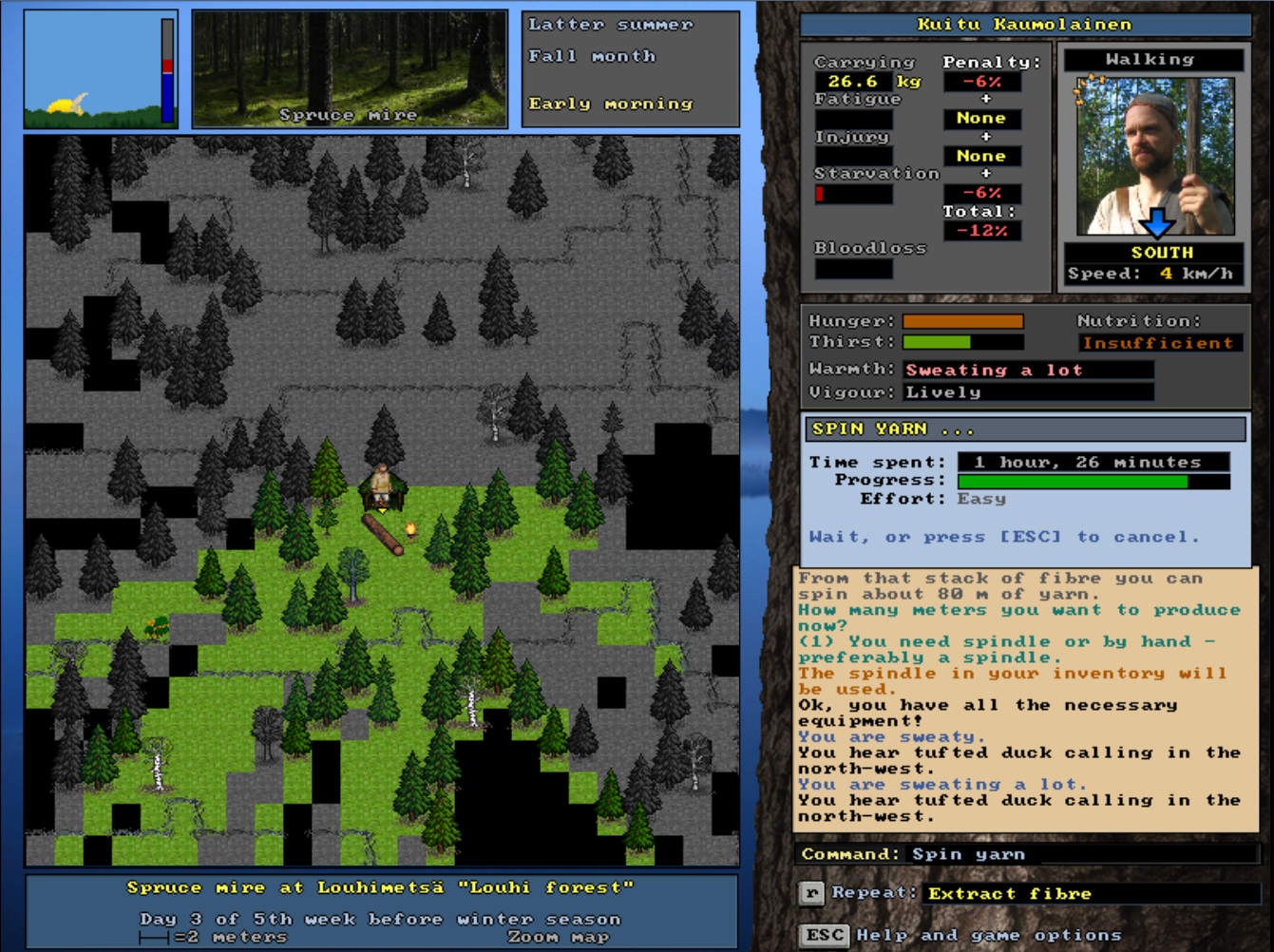 Kuitu manages to spin 80 meters of linen yarn in less than two hours. It could be then used in crafting of different items such as loop snares, arrows - or fishing rods. Nettle specialities In the next version it will be also possible to craft fishing rods, and hooks out of wood or bone. And a working fishing rod naturally needs a line too. Now Kuitu has his linen yarn which could be used as line, but the whole process of extracting flax fibres with retting and drying took weeks. That's quite a long time if there's an urgent need for little piece of yarn. Luckily there's also faster wilderness condition option for utilizing plant fibres - and that is a nettle. Nettle fibres are a speciality as they be extracted directly from the fresh plants without retting and drying processes. To do it you can simply use "extract fibre" option directly to freshly harvested nettles. This method takes more time, but is an useful option when only a small amount of fibre is needed. The nettle stem is crushed by hand, and the fibres carefully stripped off. It doesn't take long before Kuitu finds some nettles. Textile plant harvesting is made possible for fibre even when they are still growing. 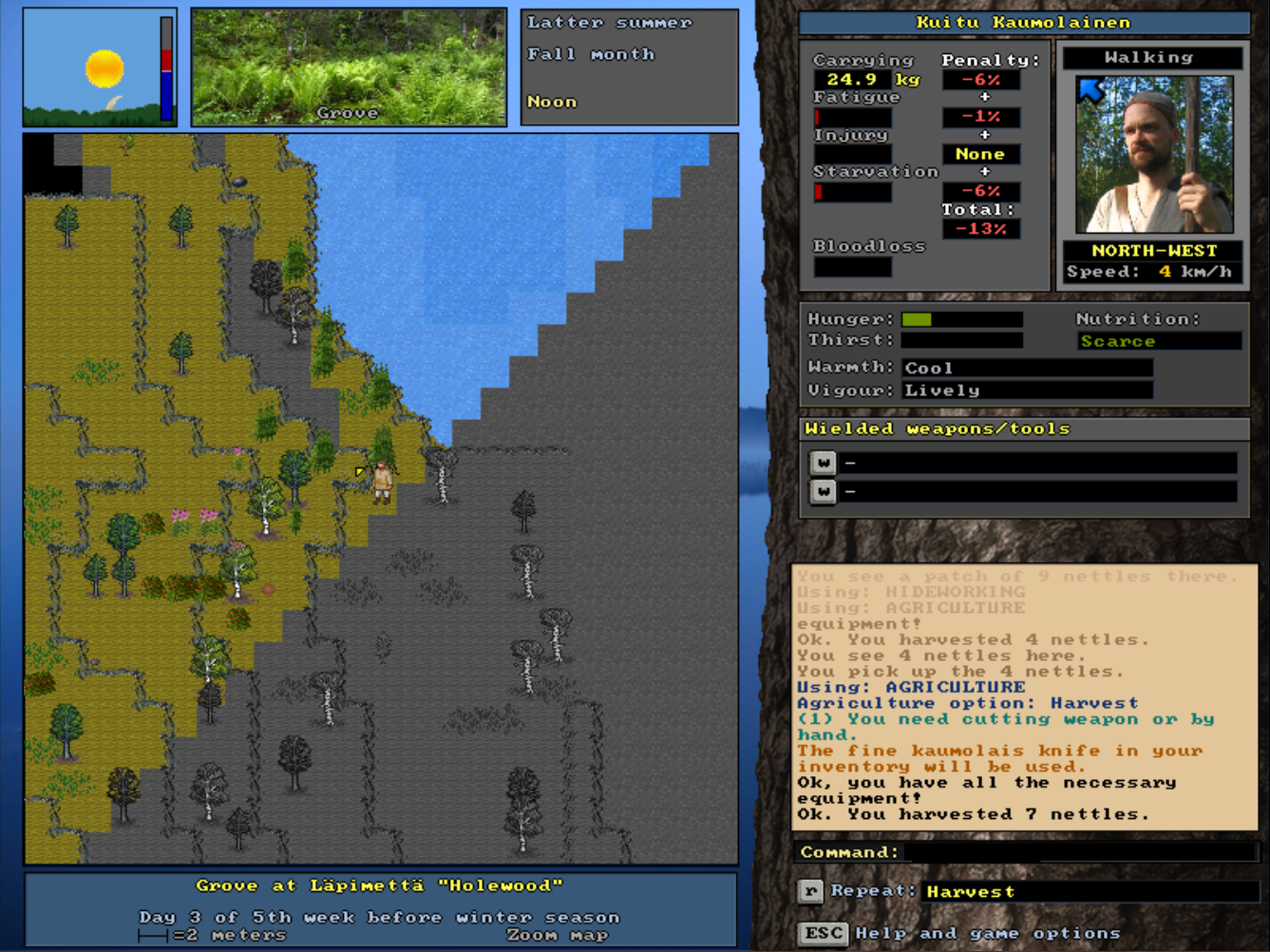 Kuitu harvests some nettles. Then he simply extracts the fibres by hand, and spins some nettle yarn. If he would like to produce a lot of yarn, this would be too slow to be practical, but now he's only after fishing rod line, Wooden hook, nettle yarn - and baits Kuitu finds a slender tree trunk, fashions a wooden hook out of a branch, and proceeds to assemble a fishing rod. Now we should mention that In the upcoming version usage of baits in fishing is also featured. Using baits is not necessary, but naturally highly recommended. Catching a fish every now and then without a bait is still possible, but for reliable rod fishing and decent catches baits are now quite essential. You can use pretty much every food item as a bait and portion of the selected item will be used during the fishing attempt. Pieces of raw meat and fish can be considered decent baits for predatory fish, but for example crumbs of bread may also work for some fish. You can also use a whole small fish, eg. roach or perch, in order to attract a bigger predatory fish. With this addition in effect the type of fish caught with rod fishing is now more dependant on the baits used. It's not likely that you'll catch a pike with an empty hook, but having a small roach as a bait might work. And that little roach might have been caught with quite moderate bait such as bread crumb, or even with some tasty vegetation. 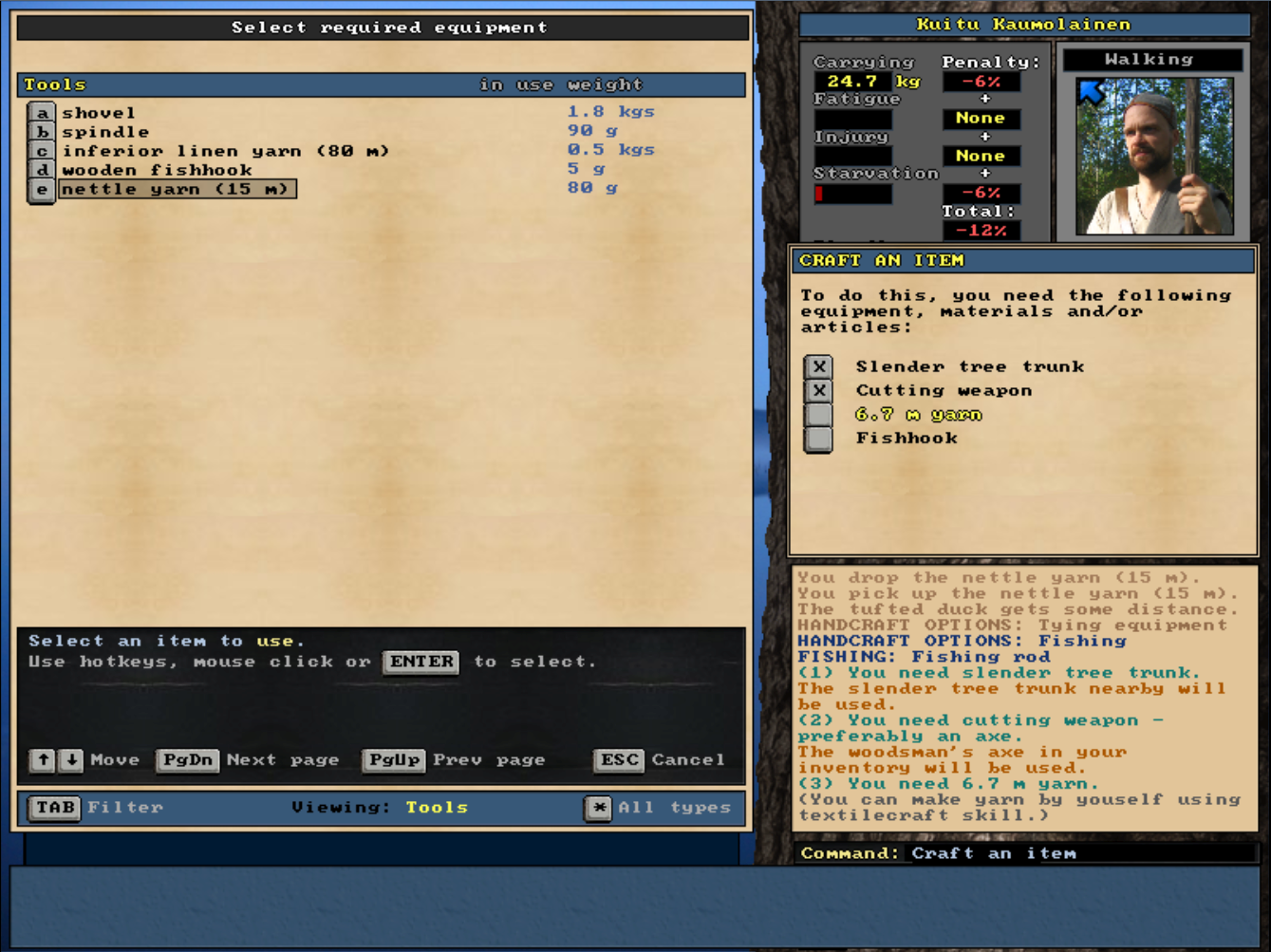 Kuitu makes his survival fishing rod, with a wooden hook and nettle yarn. The work with the several less laborous features continues but we're getting closer to release every day. It's always quite impossible to say when everything is completely wrapped up and working, but maybe - just maybe - we might have this version out in june. Cheers! For those who are more curious about the real life practises here's a short documentary in Finnish showing how the flax is processed. Having read the above I trust you will understand what is happening even without subtitles. The gear used differs slghtly from the more primitive method of the game, but the steps are the same; sow, harvest, ret, dry, extract, spin. https://www.youtube.com/watch?v=TNFD_CUlxZU May 11, 2021, 03:52:38 PM |
16 |
Re: Sneak preview of textilecraft system with screenshots and additional insight
Can you use boiling water for faster retting? Or is it too much work and not much improvement over it? I think this could add another functionality for pots in game but I have no idea if you can even do this. PALU's answer has really good points, so my answer isn't really needed, but.. well, bnoiling water is too hot, but technically you could use warmed up water and nowadays we know the optimal temperatures and all that. However, artificially warmed up retting water wasn't a practise of the ancients and it's not that in the game either. And it would be kind of waste of time since you would need to use lots of time and resources for that. If fibres are needed fast then you would go for the nettles. May 18, 2021, 02:53:04 PM |
1 |



